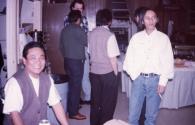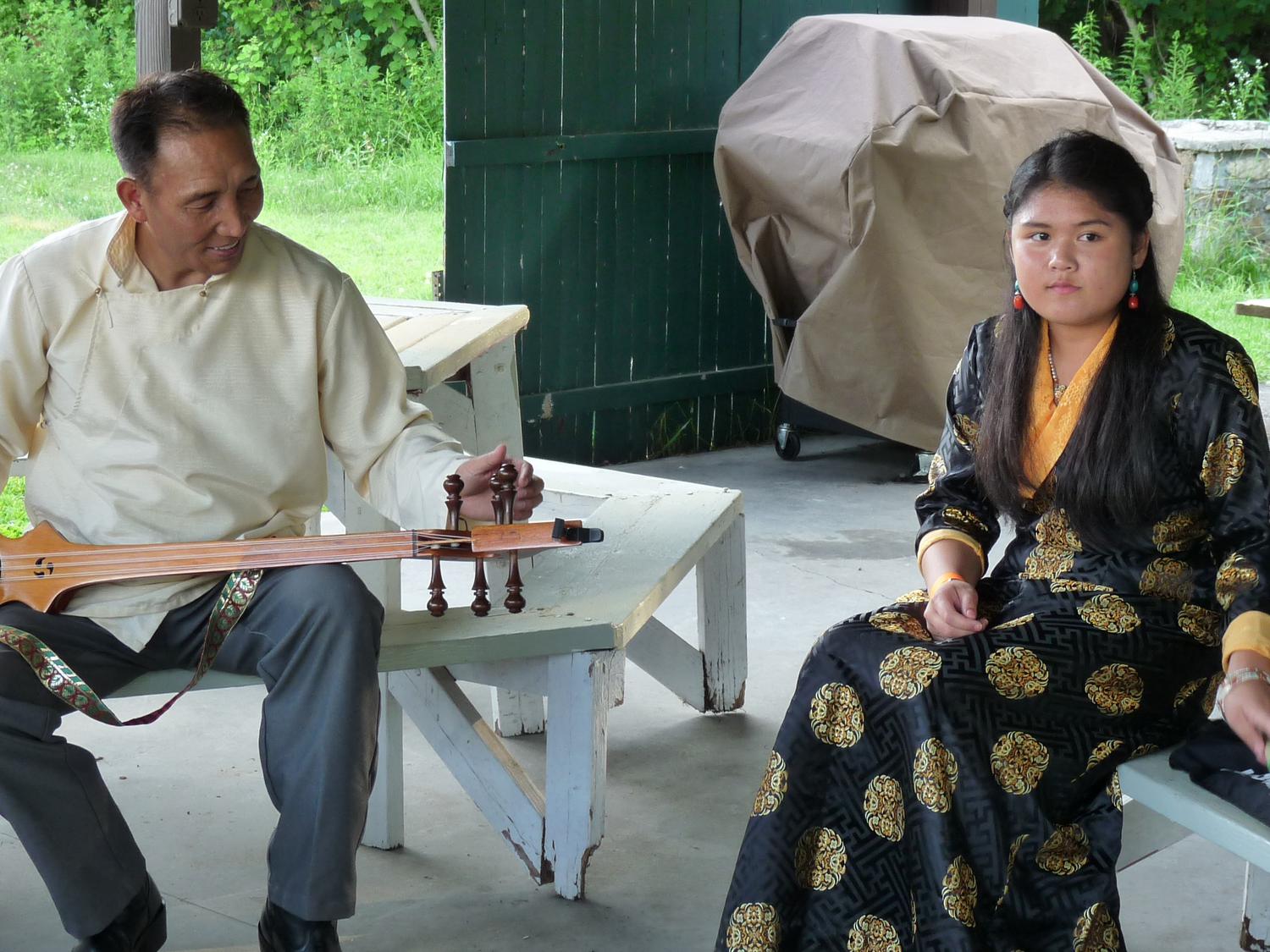Tibetan Losar (New Year) Celebration, 1997
SubjectPortrait of
Lakedhen Shingsur
(Tibetan, born 1962)
SubjectPortrait of
Ngawang Choedar
(Tibetan)
SubjectPortrait of
Tsering Yangzom
(Tibetan)
SubjectPortrait of
Dadon Dawa Dolma
(Tibetan, born 1968)
SubjectPortrait of
Thapkey Tsering
(Tibetan)
Date1997 February 15
Mediumphotography; color slide on plastic in cardboard mount
ClassificationsGraphics
Credit LineConnecticut Cultural Heritage Arts Program collections
CopyrightIn Copyright
Object number2015.196.228.1-.20
Description2015.196.228.1-.20: Photographs and slides taken at the Tibetan Losar (New Year) celebration in Old Saybrook, February 15, 1997, hosted by the Tibetan Association of Connecticut.
(.1) Lakedhen Shingsur playing flute, others singing; Kunga Choekyi stands next to Lakedhen
(.2a-b) Lakedhen Shingsur playing drum, others dancing include Kunga Choekyi (left), Kartok Dolma (red blouse), and Lobsang.
(.3a-b) Tibetans dancing at the celebration
(.4a-b) Lakedhen Shingsur playing flute
(.5) Lakedhen Shingsur playing music, others singing
(.6) Lakedhen Shingsur playing music, others singing
(.7) Tibetan folk dancing
(.8 a-b) Lakedhen Shingsur playing drum, others dancing
(.9a-b) Tibetan folk dancing; the man dancing is Pasang Gyalbo, the boy is the son of Tsering Yangzom
(.10a-b) Lakedhen Shingsur (left), Ngawang Choedar (right)
(.11a-b) Tibetan social dancing
(.12a-b) Lakedhen Shingsur playing flute
(.13) Lakedhen playing drum, others dancing include Lobsang, Tenzin Sangmo
(.14a-b) Tibetan folk dancing
(.15) Lakedhen Shingsur playing flute
(.16a-b) Tibetans seated at a table
(.17) Singer Dadon Dawadolma (left) and weaver Tsering Yangzom (right)
(.18a-b) The Losar altar, with Jampa Tsondue's thangkas displayed
(.19a-b) Lakedhen Shingsur (left), Thapkey Tsering, President of the Tibetan Association, and other Tibetans including Tsering Yangzom's family
(.20a-b) Thapkey Tsering, President of the Tibetan Association, and other Tibetans; left to right - Thapkey, Tsering Yangzom, Norbu Ngodup, Tenzin Dorka, et al.
NotesSubject Note: Since the Tibetan Resettlement Project brought 21 Tibetans from India to live in Connecticut in 1992, the state has become home to one of the fastest growing Tibetan communities in the U.S. Several Connecticut Tibetans are traditional artists of great skill who are deeply committed to expressing and passing on Tibetan culture. The story of the Tibetan community in Connecticut shows resilience and commitment to making a home in a new world. These first arrivals were sponsored to live in Old Saybrook, and they quickly found housing, jobs, and a welcome there. Many of them still had spouses, parents, and children back in India and Nepal so they applied for family reunification visas which often took years. The community has thrived and grown rapidly, choosing to remain in this part of the state. Recently the availability of jobs especially in the Asian gaming sections of Connecticut’s two casinos has encouraged many new Tibetan arrivals to settle in Norwich, bringing the community’s population up to about 500. Tibetans gather regularly for community social and ceremonial celebrations in Norwich and Old Saybrook, and they work tirelessly to educate others about the difficult situation faced by Tibetans in Tibet as they fight to protect their centuries-old culture that is threatened by a dominant political and social Chinese presence.(.1) Lakedhen Shingsur playing flute, others singing; Kunga Choekyi stands next to Lakedhen
(.2a-b) Lakedhen Shingsur playing drum, others dancing include Kunga Choekyi (left), Kartok Dolma (red blouse), and Lobsang.
(.3a-b) Tibetans dancing at the celebration
(.4a-b) Lakedhen Shingsur playing flute
(.5) Lakedhen Shingsur playing music, others singing
(.6) Lakedhen Shingsur playing music, others singing
(.7) Tibetan folk dancing
(.8 a-b) Lakedhen Shingsur playing drum, others dancing
(.9a-b) Tibetan folk dancing; the man dancing is Pasang Gyalbo, the boy is the son of Tsering Yangzom
(.10a-b) Lakedhen Shingsur (left), Ngawang Choedar (right)
(.11a-b) Tibetan social dancing
(.12a-b) Lakedhen Shingsur playing flute
(.13) Lakedhen playing drum, others dancing include Lobsang, Tenzin Sangmo
(.14a-b) Tibetan folk dancing
(.15) Lakedhen Shingsur playing flute
(.16a-b) Tibetans seated at a table
(.17) Singer Dadon Dawadolma (left) and weaver Tsering Yangzom (right)
(.18a-b) The Losar altar, with Jampa Tsondue's thangkas displayed
(.19a-b) Lakedhen Shingsur (left), Thapkey Tsering, President of the Tibetan Association, and other Tibetans including Tsering Yangzom's family
(.20a-b) Thapkey Tsering, President of the Tibetan Association, and other Tibetans; left to right - Thapkey, Tsering Yangzom, Norbu Ngodup, Tenzin Dorka, et al.
The Tibetan Association of Connecticut was formed in the early 1990s by the first Tibetans to settle in Connecticut, and it is active in bringing the state’s Tibetans together for social, cultural, educational, and spiritual events. “We have a thriving Tibetan community in State of Connecticut and this organization allows us to share common experiences of modern life in addition to keeping alive a strong sense of ancestral pride. TACT is dedicated to preserve, promote and flourish Tibetan culture for upcoming generations.”
Many of the community’s excellent traditional artists continue a wide variety of art forms as a way to sustain their language and culture and pass their heritage on to their children. Music and dance, featuring flute player Lakedhen Shingsur and dancers both young and old, are part of every Tibetan gathering especially Losar (New Year) and the Dalai Lama's birthday celebration in July. Dadon, a leading singer and composer of popular music in Tibet, was very active in performing in Connecticut and for several large Tibet benefit concerts in New York City. Yeshi Dorjee, a Buddhist monk, lives in Old Saybrook where he offers spiritual support for the community’s ceremonies and teachings. A multi-talented artist, Yeshi creates sand mandalas, butter sculptures, religious paintings, book illustrations, and is a storyteller. Jampa Tsondue paints thangkas, religious images of deities and Buddhist teachings, and has taught his daughter this process. Carpet weavers Tentso Sichoe and Kunga Choekyi participated in CCHAP’s Apprenticeship Program to share and teach their specialized craft and produce new carpets on a loom donated by weaver Tsultim Lama. Tibetan families use these folk arts every day in their homes, especially in the rooms devoted to their Buddhist spiritual practice. Many of these artists as well as other Tibetans from New York and New England participate in TibetFest, an annual gathering in Litchfield County that began in 2005.
Biographical Note: Born in Gangtok, Sikkim in 1962, Lakedhen is a natural musician who taught himself to play flute while at the Indo-Tibet Buddhist Cultural Institute school in West Bengal. He became a versatile musician also able to accompany on damyen. He formed an amateur dance and drama club which still exists to present Tibetan song and dance, learning songs from Tibetan elders living in Sikkim. For ten years he was a member of the Sikkim National Performing Arts Troupe, touring in India, Canada, the Middle East, and visiting the U.S. for the Festival of India in 1982. He has lived in Old Saybrook and Clinton, Connecticut since arriving in 1992.
Lakedhen's primary instrument is the transverse flute. Usually made of bamboo with 6 finger holes, these are played throughout the Himalayan region. As a working musician Lakedhen's repertoire included modern Indian film scores as well as the folk music of Tibet, Sikkim, and Nepal. He learned many songs from the director and other members of the song and drama troupe, representing a number of ethnic groups from the region. Love songs, traditional welcomes for guests, Buddhist spiritual lessons, historical events, dance songs, and odes to the beauty of Sikkim are some common folk song subjects.
Lakedhen has led a folk music and dance group from the Tibetan community in southeastern Connecticut, teaching traditional Tibetan music and language in the community and performing at celebrations and festivals with his music group and students. He was featured in the CD "Sounds Like Home - Connecticut Traditional Musicians" which can be heard on the CHS YouTube channel.
Additional materials exist in the CCHAP archive for this community.
Cataloging Note: This project was made possible in part by the Institute of Museum and Library Services MA-245929-OMS-20.
Status
Not on viewPenpa Tsering
2015 July 6

































